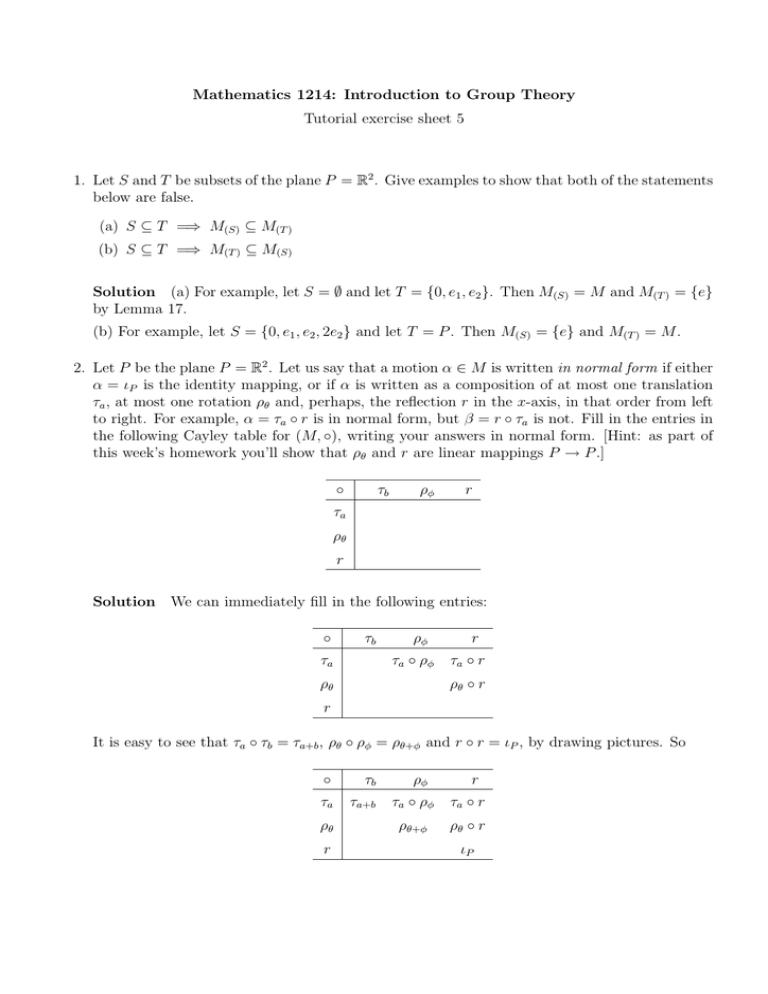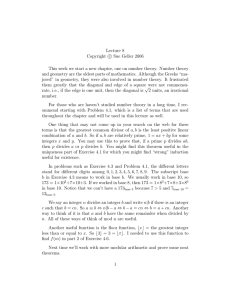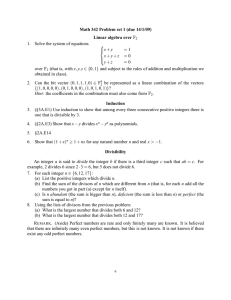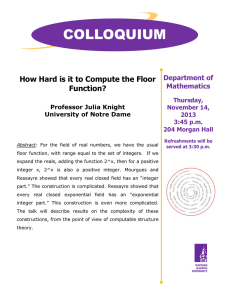Mathematics 1214: Introduction to Group Theory Tutorial exercise sheet 5
advertisement

Mathematics 1214: Introduction to Group Theory
Tutorial exercise sheet 5
1. Let S and T be subsets of the plane P = R2 . Give examples to show that both of the statements
below are false.
(a) S ⊆ T =⇒ M(S) ⊆ M(T )
(b) S ⊆ T =⇒ M(T ) ⊆ M(S)
Solution (a) For example, let S = ∅ and let T = {0, e1 , e2 }. Then M(S) = M and M(T ) = {e}
by Lemma 17.
(b) For example, let S = {0, e1 , e2 , 2e2 } and let T = P . Then M(S) = {e} and M(T ) = M .
2. Let P be the plane P = R2 . Let us say that a motion α ∈ M is written in normal form if either
α = ιP is the identity mapping, or if α is written as a composition of at most one translation
τa , at most one rotation ρθ and, perhaps, the reflection r in the x-axis, in that order from left
to right. For example, α = τa ◦ r is in normal form, but β = r ◦ τa is not. Fill in the entries in
the following Cayley table for (M, ◦), writing your answers in normal form. [Hint: as part of
this week’s homework you’ll show that ρθ and r are linear mappings P → P .]
◦
τb
ρφ
r
τa
ρθ
r
Solution We can immediately fill in the following entries:
◦
τb
ρφ
τ a ◦ ρφ
τa
r
τa ◦ r
ρθ ◦ r
ρθ
r
It is easy to see that τa ◦ τb = τa+b , ρθ ◦ ρφ = ρθ+φ and r ◦ r = ιP , by drawing pictures. So
◦
τb
τa
τa+b
ρθ
r
ρφ
r
τ a ◦ ρφ
τa ◦ r
ρθ+φ
ρθ ◦ r
ιP
2
Solution Since each rm is a reflection, we have rm 6= e and rm
= e. So o(rm ) = 2. Also,
o(e) = 1, by definition.
Now for m, k ∈ N, we have (ρm )k = (ρmπ/6 )k = ρmkπ/6 = ρ
2π·
mk
12
= e ⇐⇒
mk
12
∈ Z. So o(ρm )
is the smallest integer k ≥ 1 such that 12 divides mk. Hence o(ρ) = 12, o(ρ2 ) = 6, o(ρ3 ) = 4,
o(ρ4 ) = 3, o(ρ5 ) = 12, o(ρ6 ) = 2, o(ρ7 ) = 12, o(ρ8 ) = 3, o(ρ9 ) = 4, o(ρ10 ) = 6 and o(ρ11 ) = 12.
5. For which integers n, m ≥ 3 is Dn a subgroup of (Dm , ◦)?
Solution Dn is a group under composition, so it is a subgroup of (Dm , ◦) if and only if
Dn ⊆ Dm .
If Dn ⊆ Dm then ρ2π/n ∈ Dn ⊆ Dm , so ρ2π/n is a rotation in Dm , hence ρ2π/n = ρk2π/m = ρ2πk/m
for some integer k with 1 ≤ k < m. So 2π/n = 2πk/m, so m/n = k is an integer. So n must
be a divisor of m.
Conversely, suppose that n is a divisor of m, say m = nt for some integer t ≥ 1. The rotations
in Dn are then of the form ρ2πk/n = ρ2πkt/m ∈ Dm for some integer k, and the reflections in Dn
are of the form ρ ◦ r where ρ is a rotation in Dn , hence the reflections in Dn are also in Dm .
So Dn ⊆ Dm .
We conclude that Dn is a subgroup of Dm if and only if n divides m.
4





